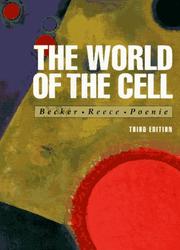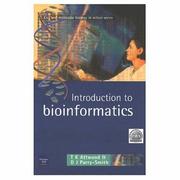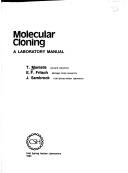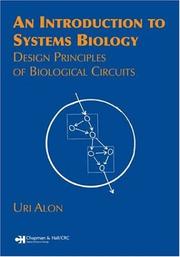| Listing 1 - 10 of 16 | << page >> |
Sort by
|

ISBN: 0805308806 9780805308808 Year: 1996 Publisher: Redwood City (Calif.): Cummings,
Abstract | Keywords | Export | Availability | Bookmark
 Loading...
Loading...Choose an application
- Reference Manager
- EndNote
- RefWorks (Direct export to RefWorks)
Histology. Cytology --- Molecular biology --- Cytology --- Cytology. --- Molecular biology. --- CYTOLOGY --- MOLECULAR BIOLOGY --- CELL BIOLOGY --- TECHNIQUES --- INSTRUCTIONS --- CELL MORPHOLOGY --- CELLS --- ENERGY FLOW --- METABOLISM --- GENE EXPRESSION --- GENOMIC LIBRARIES --- CYTOSKELETON --- MOTILITY --- SIGNALS --- TRANSDUCTION --- IMMUNE RESPONSE --- TUMOR CELLS --- MICROSCOPIC TECHNIQUES --- TREATISES --- FUNCTIONS

ISBN: 0582327881 9780582327887 Year: 1999 Publisher: Harlow : Addison Wesley Longman,
Abstract | Keywords | Export | Availability | Bookmark
 Loading...
Loading...Choose an application
- Reference Manager
- EndNote
- RefWorks (Direct export to RefWorks)
The book provides an undergraduate (final year) introduction to bioinformatics focussing on two key areas, genomics and protein sequence analysis. It provides an overview of primary, composite and secondary databases, and gives a brief introduction to the Internet and the world wide web.
Molecular biology --- Computer. Automation --- Bioinformatics --- Bio-informatique --- Biologie moléculaire --- Data processing --- Informatique --- Gene mapping --- Data processing. --- Biologie moléculaire --- Basic Sciences. Bioinformatics -- Bioinformatics (General) --- ALLW. --- 57.087 --- 57.087 Methods and techniques for parameter estimation. Recording of biological data --- Methods and techniques for parameter estimation. Recording of biological data --- Molecular biochemistry --- Molecular biophysics --- Biochemistry --- Biophysics --- Biomolecules --- Systems biology --- Molecular biology - Data processing. --- Gene mapping - Data processing. --- Basic Sciences. Bioinformatics -- Bioinformatics (General). --- Computational Biology
Book
ISBN: 1852210494 1852210486 0947946187 0947946195 9780947946197 9781852210489 9780947946180 Year: 1987 Publisher: Oxford : IRL press,
Abstract | Keywords | Export | Availability | Bookmark
 Loading...
Loading...Choose an application
- Reference Manager
- EndNote
- RefWorks (Direct export to RefWorks)
DNA --- Klonen --- 577.21 --- 575.08:577.21 --- 575.08:577.21 Genetic engineering, genetic manipulation, recombinant DNA --- Genetic engineering, genetic manipulation, recombinant DNA --- 577.21 Molecular mechanism of coding, storage and realization of inheritance information. Molecular genetics. Molecular biology of the gene --- Molecular mechanism of coding, storage and realization of inheritance information. Molecular genetics. Molecular biology of the gene --- Cloning, Molecular. --- DNA, Recombinant. --- Molecular cloning --- 57.086.8 --- Cloning, Molecular --- DNA cloning --- Gene cloning --- Cloning --- Genetic engineering --- Molecular genetics --- Clone cells --- Recombinant DNA Research --- Recombination Joint --- Genes, Spliced --- Recombinant DNA --- DNA Research, Recombinant --- Joint, Recombination --- Research, Recombinant DNA --- Spliced Genes --- DNA Transposable Elements --- Genetic Engineering --- Genetic Vectors --- Genomic Library --- Gene Library --- Artificial Gene Fusion --- Molecular Cloning --- Cosmids --- Cloning, Organism --- 57.086.8 Methods and equipment for studying living cells and tissues --- Methods and equipment for studying living cells and tissues --- Biological techniques --- Biochemical engineering --- Molecular biology --- Molecular cloning. --- Recombinant DNA. --- ADN --- cloning --- genetic engineering --- Clonage moléculaire --- ADN recombinant --- Erfelijke recombinatie. (Versch. onderwerpen) --- Clones moléculaires. (Mélanges) --- Recombinaison génétique. (Mélanges) --- Clonen (Moleculaire). (Versch. onderwerpen) --- DNA. --- DNA, Recombinant

ISBN: 0879691360 9780879691363 Year: 1982 Publisher: Cold Spring Harbor (N.Y.) : Cold Spring Harbor laboratory,
Abstract | Keywords | Export | Availability | Bookmark
 Loading...
Loading...Choose an application
- Reference Manager
- EndNote
- RefWorks (Direct export to RefWorks)
Molecular biology --- molecular cloning --- Cloning, Molecular. --- Clone cells --- Molecular Cloning --- Cosmids --- Cloning, Organism --- Eukaryotic cells. --- Eucaryotic cells --- Biological techniques --- Molecular cloning. --- Basic Sciences. Molecular Biology --- Molecular Biology (General). --- Eukaryotic cells --- Molecular cloning --- Cloning, Molecular --- DNA cloning --- Gene cloning --- Cloning --- Genetic engineering --- Molecular genetics --- Cells --- Protista --- #abib:almm --- DNA --- Amino Acid Sequence --- Eukaryotic Cells --- Methods
Book
ISBN: 9073035201 Year: 1993 Publisher: Maastricht : Natuur en techniek,
Abstract | Keywords | Export | Availability | Bookmark
 Loading...
Loading...Choose an application
- Reference Manager
- EndNote
- RefWorks (Direct export to RefWorks)
polymers --- Histology. Cytology --- genetische manipulatie --- Molecular biology --- medische genetica --- polymeren --- bio-ethiek --- Macromolecules --- Genetics. --- Molecular Biology. --- 577.21 --- 575.08:577.21 --- biotechnologie --- erfelijkheid --- ethiek --- genetica --- plantenveredeling --- 631.52 --- Biotechnologie 663 --- DNA --- erfelijkheidsleer --- 575.1 --- Biotechnologie --- Genetica (erfelijkheidsleer) --- Genetische manipulatie --- Plantenveredeling --- 615 --- Biochemie : DNA --- DNA-onderzoek --- DNA-technologie --- DNA: biotechnologie --- Biochemical Genetics --- Biology, Molecular --- Genetics, Biochemical --- Genetics, Molecular --- Molecular Genetics --- Biochemical Genetic --- Genetic, Biochemical --- Genetic, Molecular --- Molecular Genetic --- Genetic Processes --- Genetic Structures --- Genetic Phenomena --- Molecular mechanism of coding, storage and realization of inheritance information. Molecular genetics. Molecular biology of the gene --- Genetic engineering, genetic manipulation, recombinant DNA --- geschiedenis --- 575.08:577.21 Genetic engineering, genetic manipulation, recombinant DNA --- 577.21 Molecular mechanism of coding, storage and realization of inheritance information. Molecular genetics. Molecular biology of the gene --- geschiedenis. --- Geschiedenis. --- moleculaire biologie --- gentherapie --- Genetics --- Molecular Biology
Book
ISBN: 907303535X Year: 1995 Publisher: Maastricht : Natuur en techniek,
Abstract | Keywords | Export | Availability | Bookmark
 Loading...
Loading...Choose an application
- Reference Manager
- EndNote
- RefWorks (Direct export to RefWorks)
Wanneer onderzoekers ziekten en andere lichamelijke afwijkingen bestuderen, komen ze vaak veel aan de weet over dewetmatigheden van normale levensprocessen. Dat gaat zeker op bij pogingen om de oorzaken van kanker te achterhalen. Dat onderzoek heeft allerlei inzichten opgeleverd over de normale vermeerdering en ontwikkeling van cellen. Deze verhelderingen en de bijdragen daarvan in de strijd tegen kanker vormen de kern van dit uniek boek. Celdeling en kanker is geschreven door twee vooraanstaande en vermaarde biomedische onderzoekers: Harold Varmus en Robert Weinberg. Zij laten zien hoe bepaalde inzichten in het verschijnsel kanker ons begrip van normale biologische functies hebben verhelderd. Wat verstoort nu eigenlijk de fundamentele regelmechanismen van celgroei, en waardoor ontstaat de onbelemmerde, onvoorspelbare woekering die kenmerkend is voor het begin van kanker? In Celdeling en kanker lezen we hoe onderzoekers deze vragen hebben verkend door het ontstaan van kanker, de carcinogenese, tot in de vroegst waarneembare, submicroscopische stadia te volgen. Puttend uit klassieke en recente onderzoeksresultaten, leggen de auteurs uit hoe erfelijke aanleg kan samengaan met andere factoren (zoals zonlicht, straling, tabak of bepaalde virusinfecties) waardoorde genetische code radicaal verandert en een normaal gen in een kankerverwekkend gen verandert. Varmus en Weinberg beschrijven wat er bekend is over de werking van genen die kanker lijken te bevorderen (de oncogenen) en van tumor-suppressorgenen, die het optreden van tumoren juist voorkomen en inperken. De auteurs besluiten met een vooruitblik op mogelijke manieren om kanker te beheersen, gebaseerd op huidige vorderingen in het onderzoek. Dit boek is een verslag van de frontlinies van een van de belangrijkste en boeiendste wetenschappelijke ondernemingen van deze tijd. Door te lezen over het onderzoek naar het ontstaan, de aard en de mechanismen van kanker krijgt men meer inzicht in de natuurlijke ontwikkeling [onvolledig]
Molecular biology --- Oncology. Neoplasms --- Carcinogens. --- Oncogenes. --- Cell Transformation, Neoplastic. --- Cancer cells --- 001 wetenschappen --- 616-006 --- 616-008 --- celdeling --- genetica --- kanker --- oncologie --- 600.2 --- 605.91 --- DNA --- biologie --- celdelingen --- erfelijkheidsleer --- exacte wetenschappen --- geneeskunde --- gezondheidszorg --- kwaadaardige gezwellen --- proto-oncogenen --- therapie --- tumor-suppressorgenen --- 616 --- Celdeling --- Kanker --- kwaadaardige gezwellen (kanker, sarcoom) --- oncologie (gezwelziekten) --- Celbiologie en kanker --- Cells --- Pathology, Cellular --- Neoplastic Cell Transformation --- Transformation, Neoplastic Cell --- Tumorigenic Transformation --- Neoplastic Transformation, Cell --- Cell Neoplastic Transformation --- Cell Neoplastic Transformations --- Cell Transformations, Neoplastic --- Neoplastic Cell Transformations --- Neoplastic Transformations, Cell --- Transformation, Cell Neoplastic --- Transformation, Tumorigenic --- Transformations, Cell Neoplastic --- Transformations, Neoplastic Cell --- Transformations, Tumorigenic --- Tumorigenic Transformations --- Cell Line, Transformed --- Oncogene --- Transforming Gene --- Transforming Genes --- Gene, Transforming --- Genes, Transforming --- Oncogens --- Tumor Initiators --- Tumor Promoters --- Initiators, Tumor --- Promoters, Tumor --- Benzidines --- Neoplasms --- Erfelijkheidsleer --- Oncologie --- (zie ook: endocrinologie, gynecologie, hematologie) --- Carcinogenesis --- Oncogenes --- CELL TRANSFORMATION, NEOPLASTIC --- Kanker. --- Carcinogenesis. --- CELL TRANSFORMATION, NEOPLASTIC. --- Cell transformation, neoplastic. --- Carcinogens --- Cell Transformation, Neoplastic --- Carcinogen --- Oncogen --- Tumor Initiator --- Tumor Promoter --- Initiator, Tumor --- Promoter, Tumor

ISBN: 1584886420 9781584886426 Year: 2007 Volume: 10 Publisher: Boca Raton (Fla.) : Chapman & Hall/CRC,
Abstract | Keywords | Export | Availability | Bookmark
 Loading...
Loading...Choose an application
- Reference Manager
- EndNote
- RefWorks (Direct export to RefWorks)
An Introduction to Systems Biology: Design Principles of Biological Circuits builds a solid foundation for the intuitive understanding of general principles. It encourages the reader to ask why a system is designed in a particular way and then proceeds to answer with simplified models. Explains the basic circuitry in transcription regulation, signal transduction, and developmental networks Includes examples ranging from bacterial chemotaxis through developmental patterning and neuronal circuits to immune recognition Examines the principle of robustness Details how constrained evolutionary optimization can be used to understand optimal circuit design Considers how kinetic proofreading and other mechanisms can minimize errors made in biological information-processing Includes solved problems after each chapter that detail topics not discussed in the main text Thorough and accessible, this book presents the design principles of biological systems, and highlights the recurring circuit elements that make up biological networks. It provides a simple mathematical framework which can be used to understand and even design biological circuits. The text avoids specialist terms, focusing instead on several well-studied biological systems that concisely demonstrate key principles.
Biomathematics. Biometry. Biostatistics --- Mathematical statistics --- Computational biology --- Biological systems --- Bio-informatique --- Systèmes biologiques --- Mathematical models --- Modèles mathématiques --- Systems biology --- Cellule --- cells --- Biologie --- biology --- Développement biologique --- biological development --- Réseau de neurones --- Neural networks --- Mécanisme chimiotactique --- Chemotaxis --- Facteur de transcription --- Transcription factors --- Immunogénétique --- Immunogenetics --- Expression des gènes --- gene expression --- Biosystems --- Systems, Biological --- Biology --- System theory --- Philosophy --- Computational biology. --- Systems biology. --- Basic Sciences. Biology --- Mathematical models. --- Biosystematics --- Biosystematics. --- Systèmes biologiques --- Modèles mathématiques --- Bioinformatics --- Molecular biology --- Biological systems - Mathematical models
Book
ISBN: 9789033475382 Year: 2009 Publisher: Leuven Acco
Abstract | Keywords | Export | Availability | Bookmark
 Loading...
Loading...Choose an application
- Reference Manager
- EndNote
- RefWorks (Direct export to RefWorks)
Ons verhaal begint zo'n 3,8 miljard jaar geleden. Niets liet vermoeden dat de primitieve oercellen van toen aanleiding zouden geven tot de gigantische biodiversiteit van vandaag. Daarbij komen de meest wonderbaarlijke aanpassingen voor. Zo overtreffen planten - die hele ecosystemen van energie voorzien - de efficiëntie van elk zonnepaneel, hebben runderen complexe magen met micro-organismen die hen toelaten op gras te overleven, en omzeilen bacteriën steeds weer nieuwe antibiotica. De wetenschap die de verwondering over zoveel 'vernuft' vertaalt naar concrete wetenschappelijke vragen en experimenten is de biologie, de studie van het leven. Omdat alle levensvormen een gemeenschappelijke oorsprong delen, vertonen ze een opmerkelijke uniformiteit. Dat ze opgebouwd zijn uit één of meerdere cellen, DNA gebruiken als erfelijk materiaal en eenzelfde genetische code hanteren, zijn maar enkele voorbeelden die we onder de loep nemen. Vervolgens gaan we dieper in op de diversiteit van het leven: hoe passen organismen zich aan hun omgeving aan, tot welke verscheidenheid aan soorten leiden de evolutieprocessen, en hoe treden al die soorten met elkaar in interactie? Ten slotte beantwoorden we de vraag waarom de impact van de mens - eigenlijk slechts een jong twijgje aan de Stamboom van het Leven - zo ingrijpend is.
Evolution. Phylogeny --- evolutieleer --- biologie --- 575.8 --- Academic collection --- 574 --- diversiteit --- Cellen --- DNA --- Erfelijkheid --- Evolutie --- Overleven --- Voortplanting --- Biodiversiteit (bedreigde diersoorten, bedreigde planten) --- Evolutietheorie --- 112096.jpg --- Biologie --- Evolutieleer --- Evolution. Origin of species. Phylogeny --- afstammingsleer, evolutieleer --- Afstammingsleer - Evolutieleer --- BOT General Botany --- duplicates available 2014 --- life history --- origin of life --- biodiversity --- genetics --- gene expression --- cell biology --- evolution --- reproduction --- biotechnology --- human impact --- environment --- 575.8 Evolution. Origin of species. Phylogeny --- Biologie. --- Provincie West-Vlaanderen --- Biology --- biodiversiteit --- ecosystemen
Book
ISBN: 9789044808995 Year: 2008 Publisher: Hasselt Clavis
Abstract | Keywords | Export | Availability | Bookmark
 Loading...
Loading...Choose an application
- Reference Manager
- EndNote
- RefWorks (Direct export to RefWorks)
Als mama even weg moet, kan papa op zijn heel eigen manier voor de kinderen zorgen: ze doen de gekste dingen samen en laten zich helemaal gaan! Dit grappige prentenboek laat zien dat papa's net zo goed op hun kinderen kunnen passen als mama's. (Maar wel op hun manier, natuurlijk) Voor kinderen vanaf 4 jaar én hun papa's. Als mama even weg moet, zorgt papa voor de kinderen zoals alleen hij dat kan. Binnen de kortste keren wordt het een vrolijke bende. Alles kan en alles mag. Wat zou mama daarvan vinden?
Kindergarten --- Dutch literature --- olifanten (themawoord fictie) --- ouders-kind relatie (themawoord fictie) --- rolpatronen (themawoord fictie) --- kleuteronderwijs driejarigen (doelgroep) --- kleuteronderwijs vierjarigen (doelgroep) --- kleuteronderwijs vijfjarigen (doelgroep) --- prentenboeken (genre) --- peuters (doelgroep) --- Ouders --- Vaders --- Rollenpatronen --- Man-vrouwrelatie --- Prentenboeken --- Jeugdboeken 03-06 jaar --- vaders --- ouders --- prentenboeken --- dierenverhalen --- 3+ --- Dierenverhalen --- Prentenboek --- Dansen. --- Vaderschap. --- kinderboeken --- JB GENE --- olifanten --- dieren --- familie --- gezelligheid --- opvoeding --- papa --- verhalen ; +3 --- Prentenboeken ; verhalend --- Gezin ; verhalen --- Olifanten ; verhalen --- 37 --- Dansen --- Fiction --- Fundels --- Jeugdboeken --- Oppas --- Vader --- Rolpatroon --- Relatie man - vrouw --- Gesprek
Book
ISBN: 9068229095 Year: 2002 Publisher: Amsterdam Clavis
Abstract | Keywords | Export | Availability | Bookmark
 Loading...
Loading...Choose an application
- Reference Manager
- EndNote
- RefWorks (Direct export to RefWorks)
Vandaag mag Jan gaan logeren bij oma en opa. En dat is ontzettend leuk. Want opa kan best wat hulp gebruiken in de tuin en oma maakt heerlijke kersentaart. Een zacht en gezellig boek voor alle kleinkinderen en hun grootouders.
Dutch literature --- grootouders (themawoord fictie) --- oma's (themawoord fictie) --- logeren (themawoord fictie) --- prentenboeken (genre) --- opa's (themawoord fictie) --- Grootouders --- Logeren --- Koken --- Taarten --- Kersen --- Prentenboeken --- Jeugdboeken 03-06 jaar --- JB GENE --- grootouders --- logeren --- prentenboeken --- Fiction --- Jeugdboeken --- Affiches --- Grootouders ; verhalen --- Logeren ; verhalen --- OMA --- Opa --- Prentenboeken ; kleuteronderwijs --- Prentenboeken ; verhalend --- kinderliteratuur --- kleuters --- Jeugdboeken 00-03 jaar --- Grootouders. --- Logeren. --- Prentenboek 2+ --- Grootouders - prentenboek --- Logeren - prentenboek --- Grootouder --- Taart --- Kers --- Groep --- Kleinkind
| Listing 1 - 10 of 16 | << page >> |
Sort by
|

 Search
Search Feedback
Feedback About UniCat
About UniCat  Help
Help News
News